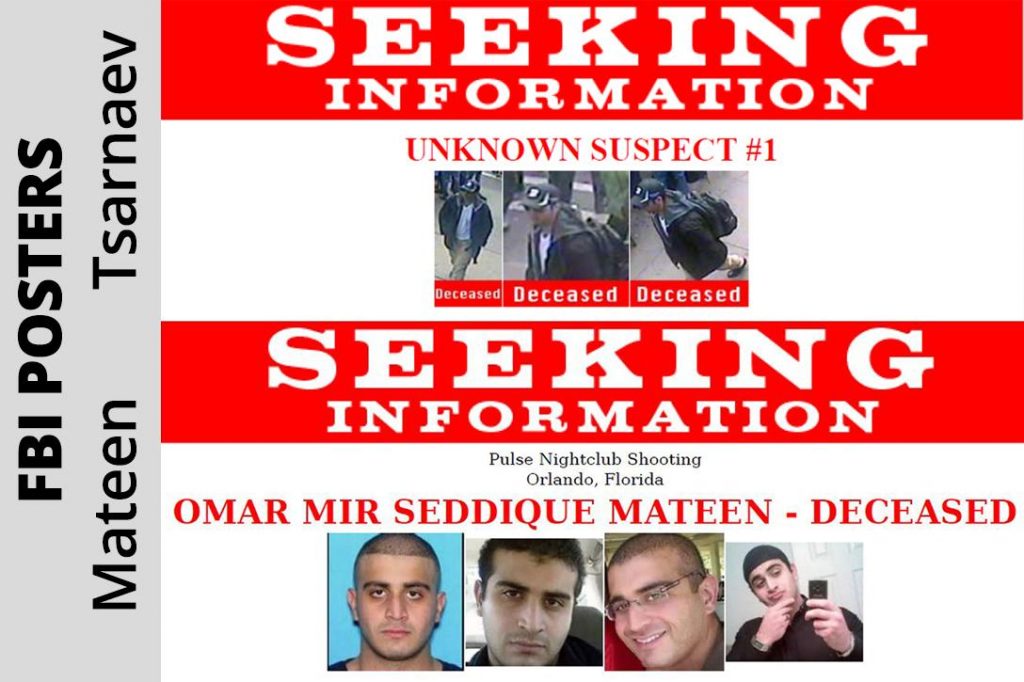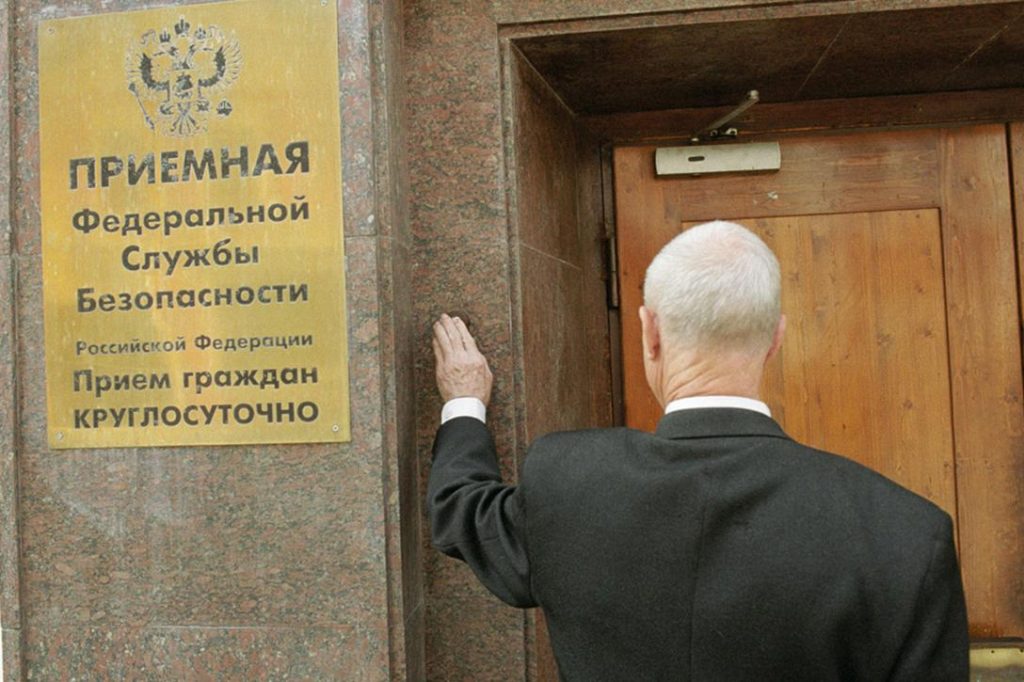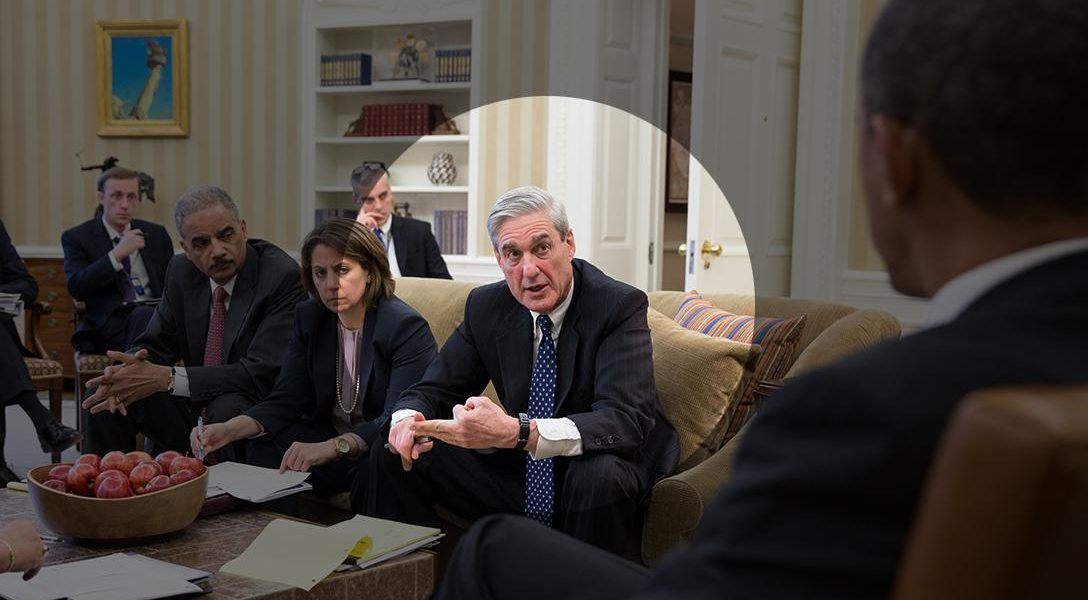Last month, we reported startling new evidence that answered the questions, What did the FBI know about accused Boston Marathon bomber Tamerlan Tsarnaev — and when did it know it? Now the public is asking the same questions about Omar Mateen. For an in-depth look at how the FBI interacts with prospective informants, please see the story below. Published two years ago, it is still highly relevant.
Introduction by WhoWhatWhy
Omar Mateen had been on the FBI’s radar for some time before he opened fire at a nightclub in Florida, killing 49 and wounding 53 people. Now the public is asking why the FBI didn’t do something to prevent the tragedy.
Glenn Greenwald responded with an article in The Washington Post, “The FBI Was Right Not to Arrest Omar Mateen Before the Shooting”. He warned that pressure on the FBI to be more pro-active will inevitably lead to more draconian anti-terror legislation and the loss of even more civil liberties in the name of preventing the unpreventable.
But there is a legitimate reason to question the FBI. There are times when the Bureau seems to be playing dangerous games with dangerous people, as shown in the article below.
This was first published in June of 2013. At the time, we said there were ‘aspects of the Boston Marathon bombing where the official story just doesn’t add up. But what if these inconsistencies point to something amiss on a far deeper level? What if the FBI’s initial claim that it didn’t know who the Tsarnaev brothers were — when in fact it knew about them for several years — hides an even bigger embarrassment?
Update. Last month, WhoWhatWhy’s James Henry reported that, despite public denials, the FBI secretly flagged Tamerlan as a terrorist threat in his immigration records. And the Bureau admitted that it conducted a six-month-long “assessment” of Tsarnaev, two years before the bombing. But then the FBI said it closed the investigation after it “found no link or ‘nexus’ to terrorism”.
Contradicting that statement, both the FBI and CIA had actually put Tsarnaev’s name on the terrorist “watch list,” stating that he “may be armed and dangerous” — and that screening him is “mandatory” if he attempts to board an airplane.
So why didn’t they do so?

Was Tamerlan Tsarnaev a Double Agent Recruited by the FBI?
.
Amid the swirl of mysteries surrounding the alleged Boston bombers, one fact, barely touched upon in the mainstream US media, stands out: There is a strong possibility that Tamerlan Tsarnaev, the older of the two brothers, was a double agent, perhaps recruited by the FBI.
If Tsarnaev was a double agent, he would be just one of thousands of young people coerced by the FBI, as the price for settling a minor legal problem, into a dangerous career as an informant.
That he was so coerced is the easiest explanation for two seemingly incompatible incidents in his life:
The first is that he returned to Russia in 2012, ostensibly to renew his Russian passport so he could file an application for US citizenship.
The second is that Tsarnaev then jeopardized his citizenship application with conspicuous, provocative — almost theatrical — behavior that seemed more caricature than characteristic of a Muslim extremist.
False Notes
.
While walking around in flashy western clothes in the Russian Republic of Dagestan, he visited his cousin, Magomed Kartashov, a prominent Islamist leader, already on the Russians’ radar. The two reportedly spent hours discussing Tsarnaev’s wish to join a terrorist cell there in the Caucasus. Later, Russian authorities asked Kartashov if he had tried to incite Tsarnaev with “extremist” views. Kartashov said it was the other way around: he had tried to convince Tsarnaev that “violent methods are not right.”
Experts agree that Tsarnaev could not have expected such provocative activity to escape the notice of the vigilant Russian authorities.
The first Russian request came in March 2011 through the F.B.I.’s office in the United States Embassy in Moscow. The one-page request said Mr. Tsarnaev ”had changed drastically since 2010” and was preparing to travel to a part of Russia “to join unspecified underground groups.”
Back in America, Tsarnaev again called attention to himself as a radical Muslim. Just one month after he returned from his trip, a YouTube page that appeared to belong to him featured multiple jihadist videos that he had purportedly endorsed.
And in January 2013, he got himself thrown out of a mosque in Cambridge for shouting at a speaker who compared the Prophet Mohammed to Martin Luther King Jr. Tsarnaev rarely attended this mosque, but he must have known it was moderate. (He had done something similar the previous November at the same mosque.) Typically, jihadists are trained to blend in, to be as inconspicuous as possible. Did Tsarnaev go to this mosque with the express intent of smoking out possible radicals?
The key to Tsarnaev’s puzzling behavior may lie in the answer to another question: when exactly did Tsarnaev first come to the attention of the FBI? The timeline offered by the agency, and duly reported in the mainstream media, has been inconsistent. One story line focused on the FBI’s response to an alert from Russian authorities.
Eric Schmitt and Michael S. Schmidt of the New York Times, wrote, on April 24, 2013,
The first Russian request came in March 2011 through the F.B.I.’s office in the United States Embassy in Moscow. The one-page request said Mr. Tsarnaev ”had changed drastically since 2010” and was preparing to travel to a part of Russia “to join unspecified underground groups.”
The Russian request was reportedly based on intercepted phone calls between Tsarnaev’s mother and an unidentified person (The Guardian [London], April 21, 2013). According to another source, several calls were intercepted, including one between Tsarnaev and his mother.
So was it the Russian alert in March 2011 that first prompted the FBI to investigate Tsarnaev? This conclusion seems undermined by another report in the Times — written four days earlier by the same two reporters plus a third — that dated the agency’s first contact with Tamerlan and family members at least two months earlier, in January 2011.
If the FBI interviewed Tsarnaev before the Russians asked them to, then what prompted the agency’s interest in him? Were his contacts here as well as in Russia considered useful to American counterintelligence?
The Canadian Connection
.
Although it’s not known why the Russians were intercepting phone calls involving the Tsarnaevs, one reason might have been Tamerlan’s connection, direct or indirect, with a Canadian terrorist named William Plotnikov. According to USA Today, a Russian security official told the AP that Plotnikov had been detained in Dagestan in December 2010 on suspicion of having ties to the militants and during his interrogation was forced to hand over a list of social networking friends from the United States and Canada who like him had once lived in Russia, Novaya Gazeta reported. The newspaper said Tsarnaev’s name was on that list, bringing him for the first time to the attention of Russia’s secret services.

Photo credit: RIA Novosti / Wikimedia (CC BY-SA 3.0)
According to a slightly different version, Plotnikov, “while under interrogation in the militant hotbed of Dagestan, named Tsarnaev as a fellow extremist.”
The similar backgrounds of Plotnikov and Tsarnaev make it likely that they had indeed been in contact. Both were recent immigrants from the former Soviet Union. Both had successful boxing careers in North America, and both surprised their friends by converting to Islamist extremism.
Plotnikov was a member of the Caucasus Emirate, an al-Qaeda ally, and the Royal Canadian Mounted Police had been searching for him since 2010. By 2011 the United States had joined the Russians in targeting this terrorist group as an al-Qaeda ally, and had offered $5 million for information leading to the capture of the group’s leader Dokka Umarov. (Moscow Times, May 27, 2011)
Plotnikov was killed in July 2012 in a shootout between militants and police in Dagestan. Tsarnaev left Dagestan for America two days after Plotnikov was killed.
US and Russia Share Concerns
.
Tsarnaev’s hopes for a Russian passport would have been put at risk by his openly provocative behavior in Dagestan unless he was acting as an informant. But for which government, the US or Russia?
The United States and Russia have two shared concerns in the “arc of crisis” stretching from Afghanistan to the Caucasus — terrorism and drugs. The two problems are interrelated, because drugs, especially in the Caucasus, help finance terror operations. This vitally affects Russia, both because it has one of the highest heroin death rates in the world, and even more because some of its member republics, like Dagestan, are up to 80 percent Muslim. This shared concern has led to a successful joint US-Russia anti-drug operation in Afghanistan.
Was Tamerlan Tsarnaev caught up in a similar counter-intelligence operation?
The FBI’s Dysfunctional Informant Program
.
One of the more controversial features of the FBI’s informant program is the frequency with which FBI agents coerce young people into the dangerous role of informant, as a price for settling a minor legal problem. Tsarnaev fits the mold. His successful career as a boxer was interrupted and his application for US citizenship was held up (and perhaps denied) because “a 2009 domestic violence complaint was standing in his way.” This alone would mark him as a candidate for recruitment.
Thousands of vulnerable young people avoid our overcrowded prisons by agreeing to become snitches, sometimes wearing a wire. In this way a person whose only crime may have been selling marijuana to a friend can end up risking his career and even his life. And for what?
According to Sarah Stillman in The New Yorker,
The snitch-based system has proved notoriously unreliable, fuelling wrongful convictions. In 2000, more than twenty innocent African-American men in Hearne, Texas, were arrested on cocaine charges, based on the false accusations of an informant seeking to escape a burglary charge. This incident, and a number of others like it, prompted calls for national legislation to regulate informant use.
After 9/11, the coercive techniques of the FBI drug war, along with half of the agents using them, were redirected to surveillance of Muslims. The emphasis was no longer on investigation of specific crimes, but the recruitment of spies to report on all Muslim communities.
In 2005 the FBI’s Office of the Inspector General found that a high percentage of cases involving informants contained violations of the FBI’s own guidelines. Its report noted that since 2001 the rules had been loosened to reflect the new emphasis on intelligence gathering and. by extension, the bureau’s urgent need for informants.
According to the Center on National Security at Fordham Law School, … nearly every major post-9/11 terrorism-related prosecution has involved a sting operation, at the center of which is a government informant. In these cases, the informants—who work for money or are seeking leniency on criminal charges of their own — have crossed the line from merely observing potential criminal behavior to encouraging and assisting people to participate in plots that are largely scripted by the FBI itself. Under the FBI’s guiding hand, the informants provide the weapons, suggest the targets and even initiate the inflammatory political rhetoric that later elevates the charges to the level of terrorism.
A writer for Mother Jones, Trevor Aaronson, also investigated the FBI’s informant-led terrorism cases for over a year; he too found that in a number of cases, “the government provides the plot, the means, and the opportunity.”
Refuse the FBI and See What Happens
.
And what happens to Muslims who refuse to become spies? The case of Ahmadullah Niazi is not atypical. Niazi was one of several members of a California mosque who sought a restraining court order against another member — actually an FBI informant — who was flagrantly advocating violence in their midst. When Niazi was subsequently asked to become an informant himself and refused, he was arrested on charges of lying to immigration officials about alleged family connections to a member of Al Qaeda. The charges were ultimately withdrawn, but by then both Niazi and his wife had lost their jobs.
Another Muslim, Khalifa al-Akili, when pressured to become an informant, complained to the Guardian newspaper in London that “he believed he was the target of an FBI ‘entrapment’ sting.” One day after the Guardian contacted al-Akili, the FBI arrested him on a felony charge for illegal gun possession, based on the fact that two years earlier he had used a friend’s rifle (at a firing range), something he was prohibited from doing since he already had a drug conviction on his record. Al-Akili was held without bail as a potential threat to the public, and ultimately convicted.
These recruitments were taking place in a climate of fear. In addition to the tens of thousands of Muslims in America who were interviewed or investigated after 9/11, there were also by 2003 (according to an American imam’s compilation of US Government figures), 6,483 detained or arrested, 3,208 deported, 13,434 in process of deportation, and 144,513 interviewed and then registered under a Special Registration program of the Justice Department.
It is instructive to study how the FBI handled drone victim Anwar al-Awlaki. Right after 9/11, Awlaki was the “go-to” imam for the US media, because of his willingness to denounce the atrocity as anti-Islamic. But a few years earlier, while a Muslim cleric in San Diego, he had been twice arrested and convicted for soliciting prostitutes. According to Awlaki, he had been set up both times, because the US government had been trying to recruit him as a spy:
In 1996 while waiting at a traffic light in my minivan a middle aged woman knocked on the window of the passenger seat. By the time I rolled down the window and before even myself or the woman uttering a word I was surrounded by police officers who had me come out of my vehicle only to be handcuffed. I was accused of soliciting a prostitute and then released. They made it a point to make me know in no uncertain terms that the woman was an undercover cop. I didn’t know what to make of the incident. However a few days later came the answer. I was visited by two men who introduced themselves as officials with the US government … and that they are interested in my cooperation with them. When I asked what cooperation did they expect, they responded by saying that they are interested in having me liaise with them concerning the Muslim community of San Diego. I was greatly irritated by such an offer and made it clear to them that they should never expect such cooperation from myself. I never heard back from them again until in 1998 when I was approached by a woman, this time from my window and again I was surrounded by police officers who this time said I had to go to court. This time I was told that this is a sting operation and you would not be able to get out of it.
Awlaki’s allegations may have been at least partly true. In 2002, when he came under suspicion in Operation Green Quest, an investigation of Muslim nonprofit organizations, the FBI reportedly did try to flip him, using prostitution charges.
According to U.S. News,
FBI agents hoped al-Awlaki might cooperate with the 9/11 probe if they could nab him on similar charges in Virginia. FBI sources say agents observed the imam allegedly taking Washington-area prostitutes into Virginia and contemplated using a federal statute usually reserved for nabbing pimps who transport prostitutes across state lines.
Were the FBI’s recruitment efforts successful? Another Muslim “person of interest,” Ali al-Timimi, tells a strange tale about al-Awlaki’s unnaturally provocative behavior:
When Awlaki came to his home, Timimi said, he started talking about recruiting Western jihadists. “Ali had never, in his whole life, even talked to the guy or met him,” Timimi’s [CHK SPELLING] lawyer, Edward MacMahon, told me. “Awlaki just showed up at his house and asked him if he could assist him in finding young men to join the jihad.” MacMahon said that Timimi was suspicious of Awlaki showing up “completely out of the blue” (Jeremy Scahill, Dirty Wars, 71).
Timimi’s attorneys argued that Awlaki was wearing a wire at the time, and asked that the US Government produce the tapes, which would show Timimi’s rejection of Awlaki’s terrorist request. The Government refused, on the grounds that “We are aware of no authority for this request.” Timimi, a promising research scientist, was convicted and sentenced to life in prison.
Another glaring indication that Awlaki had been flipped is the ease with which he was able to return to the US from studies in Yemen in 2002, even though there was an outstanding warrant for his arrest.
On October 9, 2002, the U.S. Attorney’s office in Colorado “abruptly filed a motion to have the warrant for Awlaki’s arrest vacated and dismissed.”
On October 10, Awlaki and his family arrived at JFK airport on a flight from Saudi Arabia. After a brief period of confusion, Customs officials released them and recorded later that the FBI had told them “the warrant had been removed on 10/9.” In fact, documents show the warrant was still active, and was only vacated later that day.
Asked to comment on these anomalies, former FBI agents indicated there were only two likely explanations: either the bureau let the cleric into the country to track him for intelligence, or the bureau wanted to work with him as a friendly contact.
Does a similar analysis apply to the FBI’s curious “relationship” with Tamerlan Tsarnaev?
Despite Tsarnaev’s inflammatory behavior, as reported by the Russians and also in this country, a senior law enforcement official told The New York Times that intelligence agencies never followed up on Tsarnaev once he returned to the US, because their investigation “did not turn up anything and it did not have the legal authority to keep tabs on him”
This claim sounds strange in the light of recent revelations about widespread surveillance of telephone and Internet traffic of ordinary Americans and the ease with which law enforcement officials obtain warrants to probe more deeply into the activities of anyone suspected of ties to “terrorists.”
The case of Tamerlan Tsarnaev, like that of Anwar al-Awlaki, leaves many unanswered questions. But one thing seems clear: the FBI’s informant program, especially when dealing with the War on Terror, has proliferated wildly out of control.
Related front page panorama photo credit: Adapted by WhoWhatWhy from Federal Bureau of Investigation



